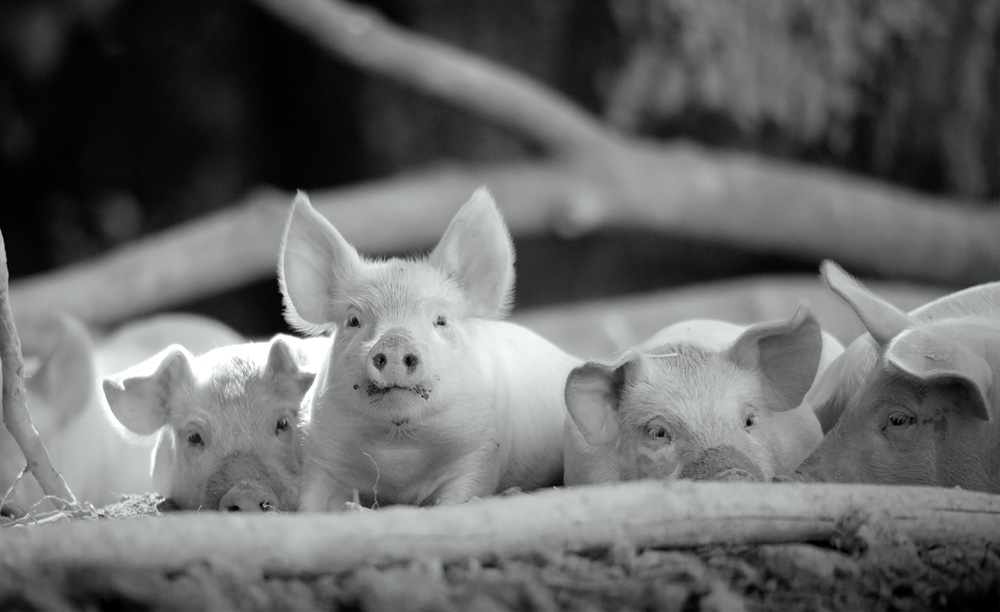It isn’t uncommon for documentaries involving wildlife to film to compile hundreds of hours of footage waiting for the perfect moment to carve out in the editing room, but for “Gunda,” Viktor Kossakovsky hit record for only six. This isn’t out of a consideration for what’s the best use of his time, but rather what’s best for the planet.
“I had this dilemma in my life — I wanted to be a cameraman, but at the same time, I knew that film itself is made from bones of animals, so I knew I shouldn’t film too much,” said Kossakovsky, alluding to the fact that emulsion is bound to celluloid with gelatin. “I should not film if I don’t need it. I shouldn’t waste it and I only can press the button when I really, really need this shot, so it’s [always] a crucial moment, something unrepeatable and something really meaningful and then in years [since], I learn how to find these moments, film them and not to lose them.”
Even with the meticulous preparation Kossakovsky puts in, as well as the advent of new cameras that have the capability to record 10 seconds prior to when he decides to start filming, “Gunda” is particularly remarkable when the filmmaker’s precision yields an intimacy with its central charismatic sow that would seem impossible to capture. To a degree, you could argue it was when Kossakovsky and crew took great pains to reconstruct a pen akin to the one they found Gunda in initially that would allow for the cameras to be as unobtrusive as possible and stitched together the farm that’s in the film with its supporting cast of cows and roosters from shoots at various sanctuaries in Norway, Spain and the United Kingdom. However, any cinematic sleight of hand is in service of getting audiences closer to the soul of its subjects, forgoing the typical anthropomorphic ornamentation to make them relatable to their human counterparts and simply bringing one into their experience so thoroughly you can’t help but see the world through their eyes.
While Kossakovsky may never have waited around for the stars of “Gunda” to do something interesting, he did show extraordinary patience in getting the film made, hoping from the time he was four to tell the story of a pig after he was gifted one to be a beloved pet. Becoming a vegetarian upon its death, the filmmaker has increasingly dedicated himself to films that instill a humility in humans regarding their place in the world, overwhelming the senses with such films as “¡Vivan las Antipodas!” and “Aquarela” that convey the mighty power of mother nature. “Gunda” is no different as one is placed at eye level with its lead as she gives birth to a gaggle of piglets in the film’s opening moments, allowing one to witness the miracle of life with the understanding how fragile it is as the babies start to find their way in the world.
After earning a great deal of acclaim following its premiere at Berlinale last year – no less than Paul Thomas Anderson is a fan – and a place on the Oscar shortlist for Best Documentary, “Gunda” is now coming out for the world to see itself and recently, Kossakovsky spoke about how his unique perspective as a storyteller was first shaped, what led him to film in black-and-white after first shooting in color, and how like any movie star, Gunda put her best foot forward during the casting process.
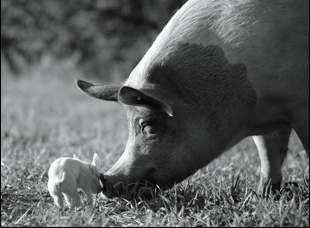
In St. Petersburg, we had a great theater for kids and every kid can play a role if you want to participate. It was kind of amateur, but [there] was a professional director who was helping us play and once when I was very little I came and he said, “You’re going to play a horse.” I said, “What?!?” He said, “Yeah, we have a short called ‘The Story of a Horse,’” and the whole story goes from the point of view of the horse. A few people own this horse through her life, like one very active boy and [someone older] and one is very rich and one is poor and her life changed every time. [The horse] was telling her story of how she saw those people around her who go through her life and suddenly, the whole world turned upside down [for me] because we normally see everything from our perspective, from the human perspective. We are central to the world. And this book of letters changed everything [for me]. I realized there is another point of view.
This was probably the starting point of my life as a person connected to art and since then, I didn’t change. I saw that everything has different points [of view] and this is quite connected to cinema. Sometimes you look for one side, but make sure you look at the same subject from another side and it might be different. Poetry is the same — you look to a tree, but a writer will say, “The tree looks like an old man who froze” and you always have this double picture. There is a Russian writer [Vladomir] Nabokov who used to say, “I want my reader to become a viewer.” And I [thought I] would continue his idea. I want my viewer becoming philosophers. This is my idea about art. Maybe it’s a little bit boring idea. [laughs]
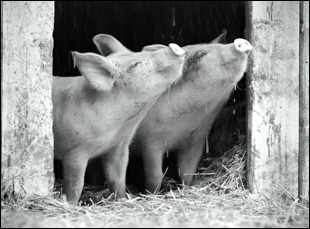
Yeah, the most popular video in YouTube is normally a video about pets – about cats, squirrels, dogs. Everyone around us, we like to film them and we like to watch them and we have this cliche [description] – “adorable.” When I started filming [“Gunda”], I saw the first images and it was so adorable. [laughs] So you don’t see personalities of animals. You just see adorable images of piglets. When they’re born, they’re so pink and so beautiful, you are melting like grandmama or grandfather. And I’m like “stop, stop, stop, stop.” We need to see their personality. We need to be sure people understand they are not something, but someone, each of them. We took color out and immediately, you pay attention to their eyes and you see character, especially with Gunda. Then every look was full of speech, even when she doesn’t speak to you. You see what she says to you, so it is a magic moment.
Also we have an unconscious knowledge that black-and-white is an ageless element, like a document saved in archives, something real and that you can prove because we used to watch archive footage of the second World War and first World War. It has this timeless quality that this is the truth, and it has value for our time and might have value in a hundred years time, so this makes me think that I have to make this movie for black-and-white because the actuality of this movie isn’t only for today, because Leonardo DaVinci said 500 years ago, “To kill an animal is the same to kill a human. It’s an act of killing.” But we still don’t listen to him. So I’m afraid my film will not change the planet radically. Some people in the younger generation will probably stop eating meat, according to the letters I’m getting, but this film isn’t a first weekend movie. It will stay long and it will make its job in time.
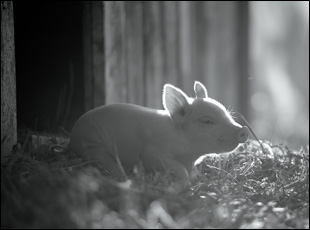
Yes, people always say how did you choose Gunda? And in fact, if I’m totally open and honest, I probably did not. Probably she did it because when we came first to the farm, I opened the door and it was many piglets there in the barn, probably 20 or so, but she was the one who came to me herself. She noticed me and she suddenly came directly to me and she looked at me so friendly, as she would be my friend. People start laughing like, “Oh, she smells you’re a vegetarian all your life and you never eat meat. This is why she came to you.” [laughs] But sometimes someone looks at you and you don’t understand what she means or understand his emotions, but with Gunda, it’s the opposite. She was like the best possible actor. She was expressing precisely her emotions and I immediately said to the producer, “We found Meryl Streep. We don’t need to search more. She is here. Look, she is talking to us,” so it was really easy.
Another unconscious element that I found so poignant after the fact was learning, like “Aquarela,” you actually shot all over the world, even though it’s presented as a single farm, which speaks to the universality of the subject matter. When did you realize you didn’t have to limit yourself to a certain region to tell your stories?
We live in the time when culture is very national, especially cinema culture. Cinema culture is always influenced by nationalities, but when you look at films about a chimpanzee or a dolphin, is it important for you that the dolphin is French or Italian? No. It doesn’t matter. It’s interesting to understand the dolphin as a creature, not its nationality, and it was important to make a film without thinking where did I film it, which year, or which country because the important thing is to see that they’re not something, but someone, and to see that they’re connectively complex creatures. They have a conscience, they have feelings and emotions — they experience happiness, joy, friendship, and suffering the same as we would experience. If our kids were taken from us, we would suffer, right? Same as Gunda, so [I had] this idea of crossing borders in a way as bigger movies [do] but in opposite way [with a] very private, tiny story of Gunda to make it universal.
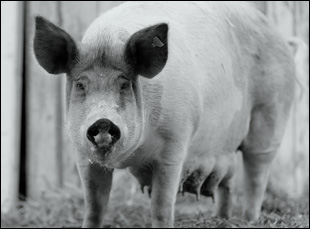
It happened naturally. We were in Los Antipodes ten years ago and to find money for the project, you have to write a human story [to pitch to producers], otherwise, no one will give you money. So I started to write this story as a human who lives on the opposite part of the planet — like for example, you are in the U.S. and if you go through the center of the earth, someone lives below you. But when I started to actually film it, there are not many places that are connected land to land because most of the planet is water, so I started in New Zealand and unfortunately…or fortunately now, I would say, I saw this huge whale on the coast who [committed] suicide, and you couldn’t pass it because it’s a huge whale and people stand around without any possibility to help. I started filming it and then I calculated what was happening on the opposite side of the world, and there was a rock the same size and shape as this whale. I didn’t believe it.
So I came to Africa and filmed in a village [where] an elephant came to the camera and showed his skin and when I came to an opposite part in Hawaii, I saw the lava looked like the skin of elephant, so suddenly nature pushed away people from my film. One by one, [I saw] one opposite after another and in the end, I [had] only two people in the film talking a little bit, but most of the film, [it’s] condors, butterflies, elephants, whale, ships, and horses, and I realized they have the same importance as humans. Then I made another movie [“Aquarela”] when water dominates the movie — it actually killed a person — and suddenly it became the main character. So it happened to me not because I thought it before, but by doing films, they change me. I became a person that cannot go back. I cannot imagine myself not respecting the planet anymore because after filming around the world, seeing all this beautiful unbelievable planet, I cannot say I didn’t see it. I saw the beautiful soul of Gunda, and I will never forget it. I know she is real. She is a person and we have to remember this. She’s not just food. She’s a person.
“Gunda” opens in select theaters on April 16th.




